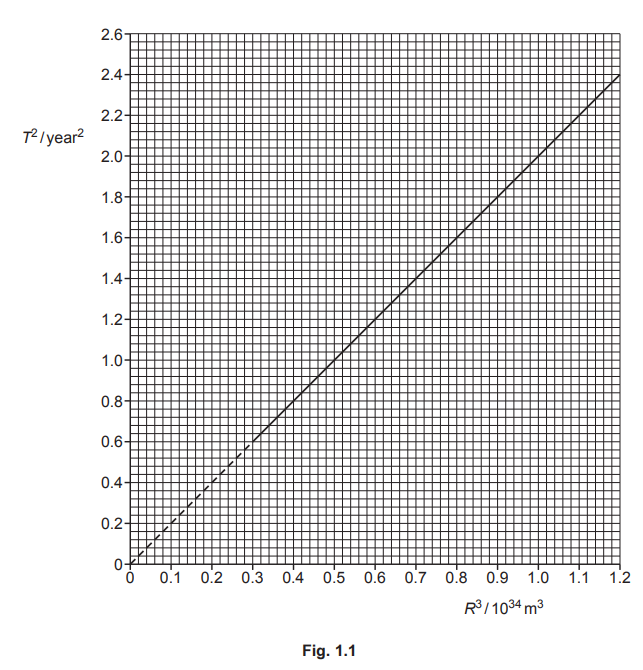Question
(a) State Newton’s law of gravitation. [2]
(b) Planets have been observed orbiting a star in another solar system. Measurements are made of the orbital radius r and the time period T of each of these planets.The variation with R3 of T2 is shown in Fig. 1.1.

The relationship between T and R is given by
\(T^{2}=\frac{4\pi ^{2}R^{3}}{GM}\)
where G is the gravitational constant and M is the mass of the star.
Determine the mass M.
M = ……………………………………………. kg [3]
(c) A rock of mass m is also in orbit around the star in (b). The radius of the orbit is r.
(i) Explain why the gravitational potential energy of the rock is negative. [3]
(ii) Show that the kinetic energy Ek of the rock is given by
\(E_{k}=\frac{GMm}{2r}\) [2]
(iii) Use the expression in (c)(ii) to derive an expression for the total energy of the rock. [2]
[Total: 12]
Answer/Explanation
Ans
(a) (gravitational) force is (directly) proportional to product of masses
force (between point masses) is inversely proportional to the square of their separation
(b) correct read offs from the graph with correct power of ten for R3
\(M=\frac{4\times \pi ^{2}\times 1.2\times 10^{34}}{6.67\times 10^{-11}\times 2.4\times \left ( 365\times 24\times 3600 \right )^{2}}\)
= × 3.0 1030 kg
(c) (i) potential energy is zero at infinity
(gravitational) forces are attractive
work must be done on the rock to move it to infinity
(c) (ii) \(\frac{GMm}{r^{2}}=\frac{mv^{2}}{r} \\) OR\(\ v^{2}=\frac{GM}{r} \ OR\ v=\sqrt{\frac{GM}{r}}\)
use of \(½ mv^2\) (e.g. multiplication by ½ m) leading to \(\frac{GMm}{r^{2}}\)
(c)(iii) \(E_p=φ m \\) and \(\ φ =\frac{-GM}{r}\) \ or\ \(E_{p}=\frac{-GMm}{r}\)
Total energy = Ek + Ep
Question
(a) (i) State what is meant by a field of force.
(ii) Define gravitational field strength.
(b) An isolated planet may be assumed to be a uniform sphere of radius \(3.39 × 10^6\)m with its
mass of \(6.42 × 10^{23}\) kg concentrated at its centre.
Calculate the gravitational field strength at the surface of the planet.
field strength = ………………………………………. \(Nkg^{–1}\)
(c) Calculate the height above the surface of the planet in (b) at which the gravitational field
strength is 1.0% less than its value at the surface of the planet.
height = …………………………………………….. m
Answer/Explanation
Ans:
(a) (i) region (of space)
where a particle experiences a force
(ii) force per unit mass
(b)\(g= GM / R^2\)
\(= (6.67 × 10^{–11} × 6.42 × 10^{23}) / (3.39 × 10^6)^2\)
\(= 3.73 N kg^{-1}\)
(c) \(0.99 × 3.73 = (6.67 × 10^{–11} × 6.42 × 10^{23}) / r^2\)
\(r = 3.41 × 10^6 (m)\)
height = (r – R)
\(= 2 × 10^4\) m
or
\(0.99 × 3.73 = (6.67 × 10^{–11} × 6.42 × 10^{23}) / (R + h)^2\)
\((R+h)^2 = 1.1596 \times 10^{13}\)
\(R + h = 3.41 × 10^6\) (m)
\(h = 2 \times 10^4\) m
or
\(0.99 = (3.39 × 10^6)^2 / r^2\)
\(r = 3.41 × 10^6\) (m)